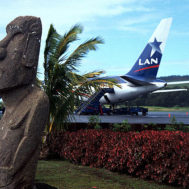UNESCO is trying a different approach, a ‘virtual museum,’ after the embarrassing failure of its The Real Price of Art campaign (which purported to depict looted antiquities that turned out to be in collections in global museums) in fictional settings with fictional stories of how they were stolen and hidden in the homes of rich people. UNESCO’s latest endeavor is the creation of a “virtual immersive reality museum of stolen cultural objects” in order to “raise awareness among [the] general public to the consequences of illicit trafficking of cultural property and contribute to the recovery of stolen objects.”
The design will be by Kéré Architecture, led by 2022 Pritzker Architecture Prize winner Diébédo Francis Kéré.
Our concern is not with the idea in the abstract, nor with the design but with how accurately UNESCO will frame the museum’s narrative. No information is available regarding the criteria for a “stolen” or “illicit” object in UNESCO’s $2.5 million prospectus. The Antiquities Coalition, a U.S. organization involved in the project said one of the most important was a stone inscription taken from the Awwam temple in Yemen between 2009 and 2011. The Antiquities Coalition describes itself as “leading the international campaign against cultural racketeering, the illicit trade in ancient art and artifacts.”
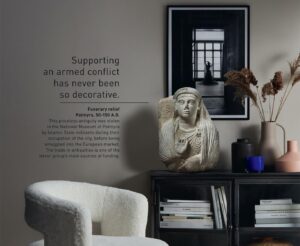
Image from UNESCO’s The Real Price of Art campaign, which misrepresented legitimate objects as “stolen.” A funerary relief thought to be from Palmyra is photoshopped into a private setting. The ad text says that it was stolen from the National Museum of Palmyra by Islamic State militants, but the Metropolitan Museum of Art reports that it acquired the object in 1901.
Cultural heritage professionals at UNESCO, museum administrators, people in academe, art historians, international lawyers and source country claimants can mean very different things by the term “stolen.” Despite having received evidence to the contrary, UNESCO continues to repeat the claim that illicit traffic in antiquities is third only to that in drugs and weapons. Spreading bad information is not only misleading, it will result in inappropriate public policies and make it more difficult to address the root causes of looting and illicit trafficking.
There will be about 600 objects shown, chosen with the assistance of Interpol and other official sources. This transparency is welcome. One reason objects remain ‘missing’ is because there or no images or documentation with which to track them. Some of the best known ‘missing’ objects are those from Carabinieri files from investigations into tombaroli that the Italian and U.S. authorities have refused to make available to museums and auction houses, preferring to play a game of ‘Gotcha!’ when an object surfaces. Will any of these make the cut?
Other items that might possibly be tracked are the dozens of fine Benin bronzes that have disappeared from the holdings of Nigerian museums since they were cataloged in the 1950s and 1960s. Will these be included? The message of this virtual museum will depend greatly on what objects are chosen and how their history is presented.
Will the virtual museum display objects dug up by looters? How will the public tell the difference between these and legitimate objects dug up by archaeologists? Will the criteria be different if the objects were taken from source countries 50, 100, 150 or 200 years ago, when these same countries’ authorities allowed their export? Or will illegitimacy of objects be presumed?
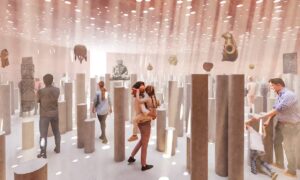
A visualisation of the planned Unesco virtual museum. Photograph: Kéré Architecture.
Obviously, the reason UNESCO wants to build a virtual museum of stolen cultural objects is because it considers the theft of cultural objects a major problem and wants to fix it. But UNESCO has a poor record in this field when it comes to delivering evidence-based information. Why not take this opportunity to find out more about the problem – to measure the actual size and scope of the current illicit market in order to know better how to halt the theft of cultural objects, and then build a virtual museum about it?
The project’s start up funding is contributed by Saudi Arabia. It would be a good idea to start by spending some of that money on a reputable study by competent analysts, in order to base the museum’s message about stolen art on facts instead of supposition.
Otherwise, all UNESCO will be doing is stamping out cat-juggling.
Former Egyptian Minister Seeking UNESCO’s Top Post Unlikely to Succeed
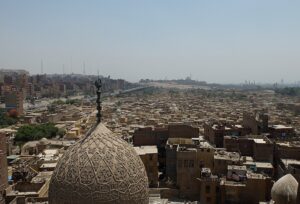
The Northern Cemetery, Cairo’s City of the Dead, seen from the minaret of Sultan Qaitbay’s mosque (dome in foreground), looking south towards the Citadel, Photo by Robert Prazeres, 19 June 2019, CCA-SA 4.0 International license.
Dr. Khaled al-Anani, Egypt’s former Minister for Tourism and Antiquities, may have trouble in securing his bid to become the next Director of UNESCO. Dr. Anani’s candidacy was recommended by the Council of Arab Foreign Ministers on September 8, 2023. However, the recommendation immediately came under fire by academics concerned over the Egyptian governments ongoing destruction of Cairo’s ancient cemeteries in the City of the Dead. These ancient cemeteries, which contain thousands of elaborate tombs dating back to the medieval period, stand in the way of a multi-lane highway from Cairo to a new administrative capital being built in the desert, part of President Sisi’s largest, multi-billion dollar development project. The City of the Dead is a UNESCO World Heritage site and UNESCO has raised concerns about the destruction since 2021.Tufts history professor Khaled Fahmy responded to the recommendation of Anani on X saying, “Shame on you.” Conservation architect and art historian Omniya Abdel Barr noted that as Minister of Antiquities, Anani refused to grant protected status to deserving sites and buildings.
Additional reading:
Kate Fitz Gibbon, UNESCO Marks Convention’s 50th Anniversary with Doctored Photos and Disinformation, Cultural Property News, November 23, 2020.
Kate Fitz Gibbon, Cairo’s Historic Cemeteries; Erasing the Dead Past, Cultural Property News, August 31, 2023
Brigitta Hauser-Schaüblin, Benin Bronzes: Why are the Victims of Slavery Hushed Up?, Cultural Property News, September 1, 2023
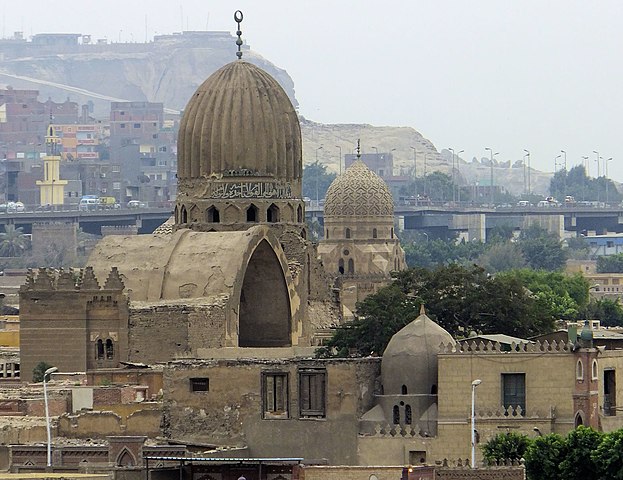 The Mausoleum and Khanqah of Khawand Tughay (or Umm Anuk), the wife of al-Nasir Muhammad, built before 1348 in the Northern Cemetery, Photo by Robert Prazeres, 16 October 2012, CCA-SA 4.0 International license.
The Mausoleum and Khanqah of Khawand Tughay (or Umm Anuk), the wife of al-Nasir Muhammad, built before 1348 in the Northern Cemetery, Photo by Robert Prazeres, 16 October 2012, CCA-SA 4.0 International license. 

